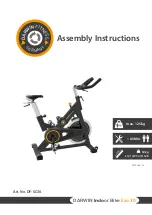
8
SUSPENSION FORK
If bicycle is equipped with suspension fork respect following instructions:
SUSPENSION SETUP
1. SPRING FORK
Fork compression setup unit is placed in upper part of right fork leg. Fork with suspension lock out
(Lockout) has compression setup unit placed on left fork leg. Turn compression setup unit clockwise
to set up higher rigidity of fork, by turning it counter clockwise the rigidity of fork decreases.
2. AIR SUSPENSION FORK
Air suspension fork compression is setup by inflating air into fork air chamber. Inflation air valve is
in upper part of left fork leg.
WARNING
Fork is adjusted by manufacturer and checked by your local dealer. Special high pressure pump
with manometer is needed for air suspension fork inflation. Particular skills and suitable tools are
needed for air suspension fork inflation and adjustment hence it is recommended to let special cycle
service do these operations.
FORK SUSPENSION LOCK OUT
Some forks have hydraulic lock out system. Fork lock out enables reduce fork teetering what
increases pedaling efficiency when riding uphill or sprinting. Fork’s lock out setup unit is placed in
upper part of right fork leg. Lock out is operated by lever (with Lockout tag). Turn lever clockwise for
lock out, turn counter clockwise to unblock suspension and fork will work in normal mode.
FORK SUSPENSION LOCK OUT REMOTE CONTROL
When bicycle has fork with fork lock out remote control (Remote Lockout) which is placed on handle
bars follow these steps: press lever or button (depends on fork model) towards handle bars to lock
out fork, press down button to unblock suspension and fork will operate in normal mode.
IMPORTANT WARNING
Fork suspension lock out is intended for use when riding in less difficult terrain. It is
necessary to unblock fork when riding in rough terrain otherwise fork lock out system could
be damaged!
REBOUND DAMPING
Rebound damping setup unit controls how fast the fork returns to original position after compression.
Setup unit is on bottom part of right fork leg. To slow fork return speed (marked by “+”) turn setup
unit clockwise (when looking on fork from bottom). To increase fork return speed (marked by “-“)
turn setup unit counterclockwise. Too slow rebound damping could cause that fork is not able to
“copy” terrain surface but too fast rebound causes fork “kicking”.
FORK MAINTENANCE
CLEANING / LUBRICATION
- regular maintenance is crucial for proper fork operation, mainly
maintenance of friction areas between outer and inner fork legs. Dust seal and gasket which keep
friction areas from contamination must be not damaged and must protect whole perimeter of
friction area. Keep clean inner leg’s sliding area, after each ride clean dust or moisture by soft
cloth and lubricate. Use detergent solution and soft brush for outer fork cleaning. When cleaning
take extra care to prevent water reach gap between inner and outer fork legs. Never use high
pressure cleaning devices. Moisture and dirt inside fork have negative impact on fork operation,
dirt inside fork cause higher friction between bushings and inner fork’s legs which may lead to fork
components lifespan shortening.
Keep following instructions to retain perfect fork operation:
•
After each ride clean up inner fork legs, dust seals and gaskets of inner fork legs from dirt like
dust, moisture or mud.
•
After each 25 hours of operation (or after each ride in extreme conditions like mud or wet sand):
1. Lubricate dust seals and gaskets by oil with Teflon.
2. Check all fork screws if they are tight enough.
3. Check any fork parts for damages. If you find any damaged or worn out fork parts replace them
by new original parts. Never ride on bicycle with damaged fork!
•
It is recommended to let special service execute fork inspection (SERVICE 1) after each 50 hours
of operation.
•
It is recommended to let special service execute fork inspection (SERVICE 2) after each 100 hours
of operation.
SERVICE 1 - recommended service operations: inspection of fork’s function, bushings cleaning and
greasing, remote control cable and hose lubrication, torque parameters checking, air pressure
checking, fork’s condition inspection oriented on legs detrition and fork parts damages.
SERVICE 2 - recommended service operations: SERVICE 1 + fork disassembling, all fork parts
cleaning, dust seals and oil wipers lubrication, remote lock out control greasing, air valve gasket
and air pressure checking, torque parameters checking.
WARNING
Use high quality lubricants which content teflon for fork lubrication. Do not use lubrications
which content lithium such lubricants could damage inner fork parts.
It is recommended to
visit special cycle service if fork maintenance requires special tool usage.
owner‘s
manual
MTB































